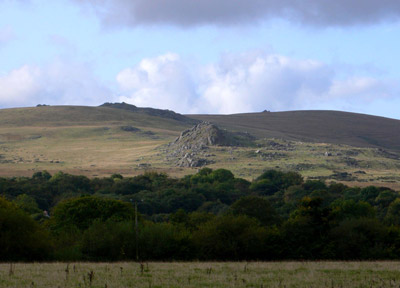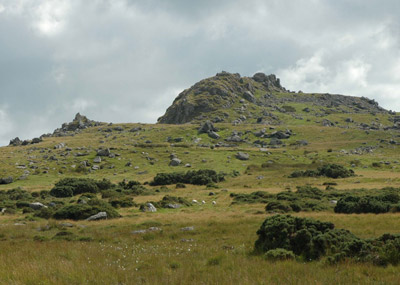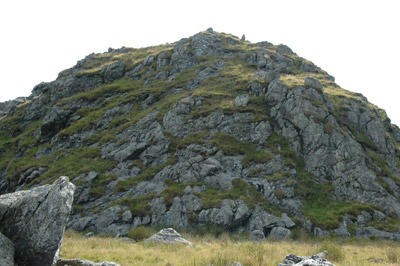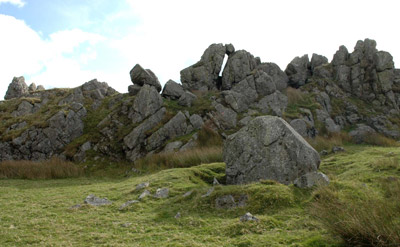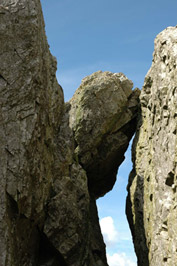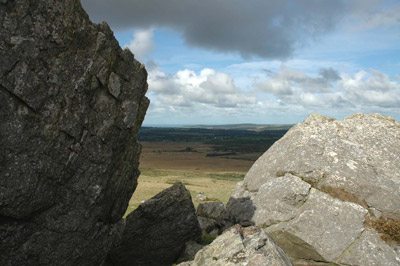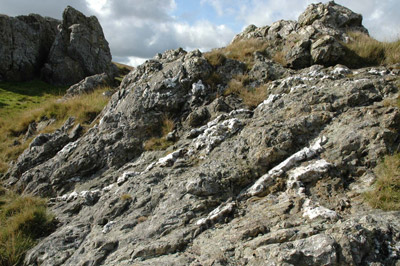We are not only looking at but listening to the Carn Menyn area of Mynydd Preseli. What would Neolithic people have heard out on that wild tract of upland? What sounds would have held significance for them – perhaps beyond what we would find meaningful nowadays? We must always bear in mind that sound in some of its less familiar forms, echoes for example, seemed far more mysterious to ancient people, who lived in a quieter world and did not possess the scientific worldview with its wave model of sound, than it does to us, in our noisy culture where we guzzle sound. As we remark in A Stone Age Holy Land?, many cultures around the world, at the same technological level as Neolithic people in Britain, thought spirits inhabited rocks and cliffs. Places where there were echoes, or where rocks made unusual sounds for one reason or another, were invariably viewed as special. As spirit rocks. Such may well have been the case on Stone-Age Preseli.
The key question arose – what would have been Stone Age sounds on Preseli? Well, first of all, of course, natural locational sounds – wind, rain, birdsong. For our whole audio-visual mapping operation, we are trying to direct our cameras and our audio-recording devices toward elemental, timeless perceptions in this ancient area to see if sensory data can help illuminate what made this tract of land, and the bluestones, so special to prehistoric peoples. We feel this overall process will help attune our modern senses to primary landscape perceptions as well as provide possible archaeological information.
Factors slowly became apparent too – echoes, the interaudibility between monuments and natural carn outcrops, the acoustics of hollows in the landscape where monuments had been placed, and, perhaps most dramatically of all on Preseli, the presence of “ringing rocks” or lithophones. We know that past generations of local people were aware of this recurring phenomenon on Preseli because of the Preseli village name, Maenclochog (see Taking A Closer Look), and this feature may have helped to make Mynydd Preseli a Stone Age holy land. So we set about trying to establish an approximation of what kind of percentage of the rocks on and around Carn Menyn do produce distinctive sounds. To do this, we have been testing rocks in random transects across the outcrops. In the process, we are gradually building up an audio-library of the acoustic signatures of the ringing rocks encountered. The work is ongoing.
As stated in Visual Mapping, for our whole audio-visual mapping operation we are trying to direct our eyes and cameras and our ears and audio-recording devices toward elemental, timeless perceptions in this ancient area to see if sensory data can help illuminate what made this tract of land, and the bluestones, so special to prehistoric peoples. We feel this overall process will help attune our modern senses to primary landscape perceptions as well as provide possible archaeological information.
We provide just a small sample of sounds here from our acoustic mapping. It is important to note that these are simply basic field recordings – more advanced recording will be taking place, both during the Pilot Study and of course during the full project when we will record whole soundfields. Some of the results of this further work will be placed on a separate page in this website in due course.
Echoes
Carn Alw
While the initial, rich acoustical seam we were able to mine during our pilot study’s audio mapping of Mynydd Preseli was lithophones (“ringing rocks”), we also kept an ear open for echo phenomena, another important aspect of archaeoacoustics. This led us to a solitary hillock crowned by a carn or rock outcrop marked as “Carnalw” on Ordnance Survey maps. It is located on the northern rim of our Mynydd Preseli study area, at SN139338. It is marked as “settlement” on the maps because the carn was used as an Iron Age fort, but it is a natural outcrop and was identified in 1923 by the petrographer Herbert Thomas as a specific source of some of the Stonehenge bluestones.
The name “Alw” apparently means “call” in Welsh, which probably relates to the carn’s echo characteristics. This might also have resonance with one of the Welsh terms for echo, carreg ateb, which literally means “stone (or rock) reply (or answer)”. This hints at possible deep associations in the Welsh language (and therefore mind) between rocks and echoes. Carn Alw is also referred to as the “Fort of Echoes” in some literature. Further literature research on all this will be conducted in a full form of the Landscape & Perception project when that can be funded.
We visited Carn Alw to test its reputation. We first checked a north-facing rock wall on the hillock. This is skirted by a flat area halfway up the carn. It was found that sounds generated on this flat area either facing, or even facing away, from the rock face did indeed produce strong echoes. We used handclapping for recording purposes as that gives a wide spectrum sound. We noticed that vocal sounds did not reflect from the rock as distinctly as did the more percussive sound produced by handclaps. The echoes gave the strong illusion of emerging from within the bulk of Carn Alw. Best distance from rock face for obtaining strongest echoes was 20-30 metres. No echoes could be produced if the handclapping or other sounds were made close to the rock face.
We also tested Carn Alw’s summit area, which is a large, flattened area of grass on which stands a massive, isolated boulder; this flat area is open to the west but bordered on the eastern side by a rock escarpment, resembling a natural amphitheatre. We expected that this arrangement would produce even stronger echoes, but, surprisingly, this proved not to be the case. While there were echo phenomena on the summit, they were not as strong as those on the outer, north-facing rock wall.
Preliminary testing produced no distinctive lithophone results.
The fact that lithophones along the Carn Menyn ridge and the echoes at Carn Alw offer separate kinds of exceptional acoustic effects tends to suggest that sound may have been an important factor in making the general location special to Neolithic people, imbuing rocks taken from there with a magical property, a kind of mana or supernatural potency, and as already noted, cross-culturally in the ancient world, sounds from stones were perceived as emanating from spirit inhabitants of rock and cliff interiors






